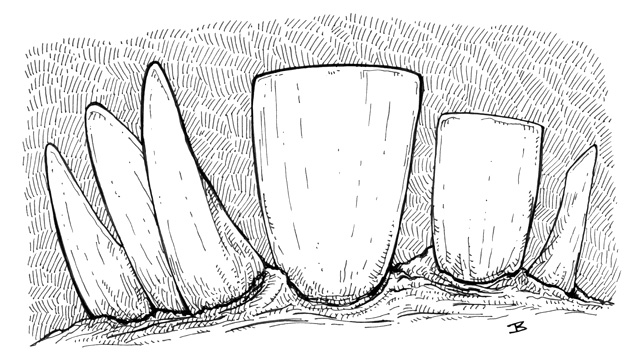CHITINOUS DRAGON (Lesser)
FREQUENCY: Very Rare
NO. APPEARING: 1-2
ARMOR CLASS: 0
MOVE: 9"/18"
HIT DICE: 7-9
% IN LAIR: 50%
TREASURE TYPE: H, R, S, T
NO. OF ATTACKS: 4
DAMAGE/ATTACK: 1-4, 1-4, 2-12, 1-12
SPECIAL ATTACKS: Breath weapon, poison sting
SPECIAL DEFENSES: Nil
MAGIC RESISTANCE: Standard
INTELLIGENCE: High
ALIGNMENT: Lawful Good
SIZE: L (14' long)
PSIONIC ABILITY: Nil
Attack/Defense Modes: Nil
CHANCE OF: Speaking: 70%
Magic Use: 40%
Sleeping: 20%
These dragons prefer to live in high places or high
points in the landscape. Their lair is usually some remote place which is
particularly hard to access. They are very interested in the world around them,
with some travelling from high point to high point closely observing what they
see en-route. Others prefer to hunker down at one particular high point and
watch whatever passes by - in fact, some can easily be mistaken for mossy rocks
or similar features if they have been observing for a prolonged period of time.
They have a faultless memory, and can effortlessly recall minute details about
anything that they have seen. Because of this, they are very useful sources of
information about their locale but will ask many and varied questions in
exchange. Any creature that tries to lie to the dragon will never be able to
speak with it again, and the conversation will come to an abrupt halt.
Lesser Chitinous Dragons are usually loathe to engage in combat, but if need be the dragon can opt to fight with either a pair of small, sharp claws and a stabbing beak, a breath weapon, or with a poisonous sting. Its breath weapon is an acidic gas 5" long, 3" wide and 3" high that will blind any creature for 2-12 rounds. A barb in it's short flexible tail attacks with +2 to hit, and any creature struck by it must save versus poison at -2 or be paralysed for 1-8 rounds. If the dragon can speak and employ magic, they will know 1-6 spells up to 5th level. Roll randomly to determine which spells they know.
Description: The Lesser Chitinous Dragon resembles a large beetle or tortoise with a short hooked tail and long pointed head. It flies using a pair of opaque wings which fold backwards and lie flat against its carapace when not in use. Their chitin can be made up of a wide variety of colours, although those that prefer a more sedentary lifestyle chose colours that best blend with their environment. Those that can speak do so with a soft, melodious tone and will be very keen to converse and exchange information with any creature that engages them in conversation. If two are encountered, they will be a mating pair.




















+012.jpg)






